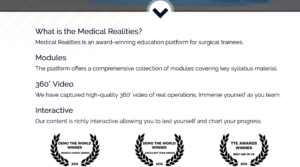VR With Obvious Value

Medical Realities: an educational platform that leverages VR to improve surgical training
A theme we’ve all encountered in VR is, what value is it really creating beyond providing high-tech toys to the rich? Another objection: can the value added justify the cost? Well Medical Realities is playing in a space where their value proposition doesn’t even need justification, because, how do you measure the cost of a human life?
Medical Realities is a company that has developed a usage application for VR in an area that unquestionably matters to everyone – medicine. It is a tech- and VR-enabled education platform that is designed to enhance training for surgical trainees. Students will be able to use VR technology to observe 360 degree videos of real-life surgeries, vastly expanding the scope of cases to which every trainee can have access. The platform (currently pre-release) will have built-in interactive features that will enhance training for students.
Value Creation
The platform creates value for a host of stakeholders. For training hospitals, the cost of delivering practical training is associated with the expense-laden cost structures of hospitals, so the ability to move even a small portion of practical skills training out of hospital assets can have potentially huge paybacks. For everyone vested in the education of surgeons (the hospitals, training programs, educators, patients and surgeons themselves), the platform creates value by removing a traditional barrier to surgical training: exposure. Right now, surgeons have to wait to encounter a patient with a specific condition to be able to experience the surgery to treat it, and when such a case arrives, trainees in the hospital compete with each other for the coveted opportunity to scrub in. This platform can democratize access to surgeries, which can be integrated in to surgical training in 3 ways: 1) Surgical trainees can be better prepared the first time that they perform a new surgery, because they will have knowledge of the procedure beyond written materials, contributing to better patient outcomes; 2) more surgeons can become familiar with a host of rare procedures, increasing patient access to the specific training that their conditions require; and 3) students can gain exposure to surgeries from much earlier in their educational process without jeopardizing patient outcomes for the sake of training.
Value Capture
The platform is currently pre-release, so they are not yet capturing value. They have specified that they will capture value through subscription pricing, which I believe to be an sound method of value capture. So long as the platform delivers the educational quality that it promises, the subscription is likely to be sticky as training programs have continual intake of new trainees who can benefit from using the platform. They have not released pricing yet, but medical institutions are not typically price-sensitive enough for us to assume that price would be a major hurdle. The alternative would be a system of sharing in cost savings, but this would be costly and difficult to measure continually, and would represent a major barrier to adoption.
Where I do believe they may face a challenge is in how to continue generating content. If they are filming live surgeries, they are producing content using the hospital’s assets, and it is unclear whether or not a commitment to spreading better medical training would be sufficient for any given hospital administrator to agree to providing that access free of charge, and they will need the administrative staff to manage negotiating agreements with multiple hospitals. To address this, I would recommend approaching the relevant consortiums or trade groups that influence educational practices across hospitals, as the educational benefits would likely garner support for them.
Recommendations
The company is likely to see demand coming from many different directions, and will have to decide how to prioritize the sequence in which they develop new content. The website advertises the interactive features, but it is unclear exactly how those will manifest. A key strategic recommendation that I would make to Medical Realities is to dedicate resources to continually improving their interactive features towards building full VR simulations of real surgeries. This would enhance the value of any new material that they develop and could be a key competitive advantage.
The company will also have to set chronological priorities for which surgical techniques to produce. The perception of the value of the platform will be impacted by this decision, as educators are unlikely to incorporate use of the platform in to their training programs if they feel that the skills offered are only peripheral to the required education. Medical Realities should partner with one or more training programs to ensure that the experience that they are providing remains beneficial as the field develops.
The company will also have to select a target use case: are they going to try to teach the most common and basic skills and position the platform as a tool to help students gain mastery without jeopardizing patient outcomes? Or are they trying to create access to surgeries that are usually less accessible? This choice will impact how they will be able to form relationships with educational institutions.
——
In a world where Snapchat was valued at $22B but Washington only provides $4.9B of funding to cancer research every year, it is refreshing to see companies that are aiming to harness the potential for technologies in ways that matter. Ultimately, Medical Realities will be granted a much more flexible learning curve by its customers because this is a case where everyone’s motivations and incentives are aligned.




